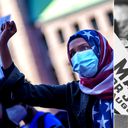The photos of protests following George Floyd's death are disturbingly familiar.

Published Date: 5/30/2020
Source: axios.com
The photos of protests around the country following the death of George Floyd during an encounter with Minneapolis police are hauntingly familiar. We’ve seen them many times before, going back decades.Why it matters: "What is also unmistakable in the bitter protests in Minneapolis and around the country is the sense that the state is either complicit or incapable of effecting substantive change," Keeanga-Yamahtta Taylor, an assistant professor of African-American studies at Princeton University writes in the New York Times. The images that follow make all too clear how little has changed since the modern Civil Rights Movement began in the 1950s. Now: Baltimore police arrested Freddie Gray, 25, on April 25, 2015, and charged him with carrying a knife. While in police custody, he fell into a coma and died a few days later. Protests started and quickly escalated after police failed to release information regarding Gray's injuries. The police officers charged with his death were either acquitted or their cases ended in mistrials. Officers carry a man to a police van for violating the 10 p.m. curfew implemented due to protests over the death of Freddie Gray in Baltimore in April 2015. Photo: Jabin Botsford/The Washington Post/Getty ImagesThen: By April 1963, there were 758 civil rights protests organized in 186 cities and more than 14,733 arrests, The Guardian reports. In New York, Congress of Racial Equality organized against employment discrimination. A woman is carried to a police patrol wagon during a civil rights demonstration in Brooklyn, N.Y. in 1963. Photo: Education Images/Contributor/Getty ImagesNow: Protesters in Los Angeles began mostly peaceful demonstrations on Wednesday, their frustrations over police brutality and the killing of George Floyd in Minneapolis very clear. A protester occupies an intersection in Los Angeles after a Black Lives Matter Protest in solidarity with other national demonstrations following George Floyd's death. Photo: Gabriella Angotti-Jones/Los Angeles Times/Getty ImagesThen: Sanitation workers in Memphis, Tenn., went on strike in February 1968 following the deaths of Echol Cole and Robert Walker in a garbage truck compactor. The workers were demanding better pay and safer working conditions, and Martin Luther King Jr. traveled to Memphis to support them just before his assassination on April 4, 1968. Civil Rights activists are blocked by National Guardsmen brandishing bayonets while trying to stage a protest in Memphis, Tenn. The marching demonstrators were also flanked by tanks. Photo:
Bettmann/ Contributor/Getty ImagesNow: The death of George Floyd sparked protests in Minneapolis, New York City and Los Angeles. Despite the coronavirus pandemic, protesters have taken to the streets calling for police brutality to end. Harina Yacob, 26 of Los Angeles wears a face mask that says, "Please, I can't breath" as people protest following the killing of George Floyd in Minnesota by police. Photo: Jason Armond/Los Angeles Times/Getty ImagesThen: Martin Luther King Jr. led a march from Selma to Montgomery, Ala., to press for voting rights. Even as the protesters marched peacefully, the police attacked and arrested them. A man with a straw hat that reads 'Freedom' on its band walks with others during a march for voting rights from Selma to Montgomery, Ala., in, late March 1965. Photo: Robert Abbott Sengstacke/Getty ImagesNow: Riots consumed Ferguson, Mo. after a white police officer shot and killed Michael Brown, an unarmed black teenager. The shooting led to weeks of protests, some of which turned violent. Police used rubber bullets and tear gas on the crowds. Tear gas reigns down on a woman kneeling in the street with her hands in the air after a demonstration over the killing of teenager Michael Brown by a Ferguson police officer in August 2014. Photo: Scott Olson/Getty ImagesThen: Activists in Birmingham, Ala., worked to end the city's segregation laws. Known as the Birmingham Campaign, it was one of the most influential efforts of the Civil Rights Movement. Firefighters spray protesters during the Birmingham Campaign in Alabama in May 1963. Months later, a bomb at the 16th Street Baptist Church in Birmingham would kill for young black girls and injure many others.Now: Demonstrations grew to nearly 30 U.S. cities, including Los Angeles, over four days to protest the killing of George Floyd during an encounter with Minneapolis police, and more are planned. Protesters in downtown Los Angeles after a Black Lives Matter demonstration on May 17, 2020, over the death of George Floyd in downtown Los Angeles. Photo: Gabriella Angotti-Jones / Los Angeles Times via Getty ImagesThen: “We maintained the hope while transforming the hate of traditional revolutions into positive nonviolent power. As long as the hope was fulfilled there was little questioning of nonviolence. But when the hopes were blasted, when people came to see that in spite of progress their conditions were still insufferable … despair began to set in...Darkness cannot drive out darkness: only light can do that. Hate cannot drive out hate: only love can do that. The beauty of nonviolence is that in its own way and in its own time it seeks to break the chain reaction of evil,” Martin Luther King, Jr., wrote in his 1967 book, Where Do We Go from Here: Chaos or Community. Martin Luther King, Jr., and his wife, Coretta Scott King, lead a voting rights march from Selma, Alabama, to the state capital in Montgomery. Photo: William Lovelace/Express/Getty ImagesGo deeper...In photos: Protests over George Floyd's death grip Minneapolis